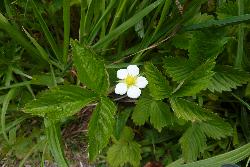- Taxon
- Gallery
- ≡ Potentilla vesca (L.) Scop. (1771)
Low-growing herb with short woody stock, up to c. 15–(25) cm high; runners greenish, pilose, bracteate, up to c. 80 cm long and rooting at nodes and tips to form new rosettes. Basal lvs several in rosette; petiole up to 15–(18) cm long, densely pilose; leaflets ovate to rhombic or elliptic, obtuse to subacute, cuneate at base, ± thin, bright green above and usually sparsely to moderately silky pilose, rarely almost glabrous, paler below and usually silky pilose at least on veins, with margins coarsely serrate in upper 1/2-⅔ and pilose; terminal leaflets (15)–30–60–(90) × (10)–18–40–(50) mm; lateral leaflets slightly smaller; petiolules very short or 0, silky pilose; stipules triangular, 12–20 mm long, reddish brown, ± pilose especially along axis. Scape (30)–60–180–(300) mm tall, ± erect and often arching in upper part, finely pilose; infl. of 1-several fls; pedicels 7–40 mm long; fls 10–18 mm diam. Epicalyx segments narrow, ± entire. Sepals triangular, 4–6–(9) mm long, pilose, ± acuminate, connate at base, deflexed at fruiting. Petals obovate, up to 8 mm long, sometimes only slightly > sepals, rounded, sometimes undulate, spreading, white. Achenes uniformly scattered over and projecting from the receptacle; receptacle usually red, occasionally white, swollen and juicy, sweet, fragrant, obconic, up to 15 × 12 mm.
[From: Webb et al. (1985) Flora of New Zealand. Volume 4 as Fragaria vesca L.]




